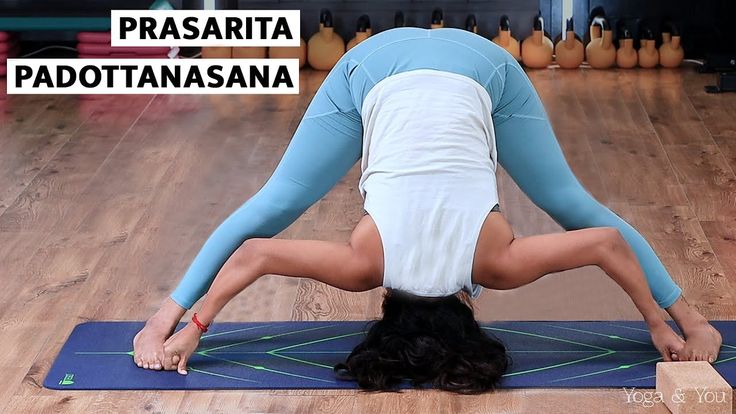Discovering the Depths of Prasarita Padottanasana: A Guide to Wide-Legged Forward Bend:
Introduction
In the world of yoga, certain poses invite us into a deeper understanding of our body, mind, and spirit. Prasarita Padottanasana, or the Wide-Legged Forward Bend, stands out as a foundational asana that offers a multitude of benefits to those who practice it regularly. Originating from the Sanskrit words ‘Prasarita’ meaning spread out, ‘Pada’ meaning foot, ‘Uttana’ meaning intense stretch, and ‘Asana’ meaning pose, this asana encourages an intense stretch across the body while grounding and stabilizing the mind. Let’s embark on a journey to explore the wide-reaching benefits of this pose, how to perform it, its variations, and how it can be integrated into your yoga practice for holistic well-being.

The Benefits of Prasarita Padottanasana
1.Physical Benefits
Prasarita Padottanasana is a powerhouse of a pose, targeting the hamstrings, calves, hips, and back. It strengthens and stretches these areas, promoting flexibility and improving circulation. Additionally, the inversion aspect of the pose aids in refreshing the brain and relieving mild depression by increasing blood flow to the head.
2.Mental Benefits
This pose challenges your balance and focus, leading to improved concentration and a calm, meditative state of mind. The forward bend encourages introspection and the release of stress, making it an excellent practice for mental clarity.
3.Emotional Benefits
Engaging in Prasarita Padottanasana can be a profound emotional release, helping to let go of stress, anxiety, and fatigue. The act of bowing forward is often seen as a gesture of surrender, allowing practitioners to release emotional baggage and embrace a sense of peace.
How to Perform Prasarita Padottanasana
Step-by-Step Guide
- Starting Position: Begin standing in Tadasana (Mountain Pose) at the top of your mat. Step your feet about 4 to 5 feet apart, ensuring they are parallel to each other.
- Hands on Hips: Place your hands on your hips, inhale, and lengthen your torso.
- Exhale and Fold: Exhaling, fold forward from your hip joints, not from the waist. Keep the spine long and the neck relaxed.
- Hand Placement: As you fold forward, place your hands on the floor beneath your shoulders, palms down. Ensure your fingers are in line with your toes.
- Deepen the Pose: With each exhale, deepen your forward fold, aiming to bring your head closer to the floor. However, listen to your body and only go as deep as comfortable.
- Exiting the Pose: To exit, inhale and lift your torso back to standing, hands on hips, then step back to Tadasana.
Common Mistakes
- Overstretching: Avoid pushing too hard into the stretch, which can lead to hamstring or lower back injuries.
- Misalignment: Ensure your feet are parallel to keep the hips aligned and prevent undue strain on the knees.
Modifications and Props
- Blocks: If your hands don’t comfortably reach the floor, use blocks under each hand to support your weight and maintain alignment.
- Strap: For those with tight shoulders in variations requiring hand clasping, a strap can be used to bridge the gap between the hands.
Variations of Prasarita Padottanasana
Exploring the variations of Prasarita Padottanasana can deepen your practice and introduce new dimensions to this versatile pose. Here are the main types:
- Type A (Hands to the Floor)
This variation focuses on maintaining a long spine and engaged core, offering a less intense forward fold while still providing the benefits of the inversion.
- Type B (Hands on Hips)
Placing hands on the floor provides additional support, allowing for a deeper forward fold and greater hamstring stretch.
- Type C (Hands Clasped Behind Back)
This variation adds a shoulder stretch to the forward fold, deepening the release in the upper body and enhancing the benefits of the inversion.
- Type D (Hands Holding Feet)
Extending the arms forward intensifies the stretch along the back anshoulders, promoting flexibility and strength in these areas.
Integrating Prasarita Padottanasana into Your Yoga Routine
When to Practice: This pose works well as a transition between standing poses or as part of a cooling down sequence, thanks to its calming effect on the mind and body.
Complementary Poses: Pair Prasarita Padottanasana with other standing poses like Trikonasana (Triangle Pose) or as part of a sequence leading to deeper forward bends and inversions.
Contraindications and Cautions
Who Should Avoid: Individuals with lower back injuries, high blood pressure, or hamstring issues should proceed with caution or consult a healthcare provider.
Safety Tips: Always warm up before practicing deep forward bends and never push beyond your comfortable limit to prevent injury.
Personal Experience and Tips
From my journey with Prasarita Padottanasana, I’ve learned the importance of patience and consistency. Starting with modifications and gradually working towards the full pose allowed me to experience its full benefits without injury. My advice for beginners is to focus on alignment and breath, allowing the body to open up naturally over time.
Conclusion
Prasarita Padottanasana is a multifaceted pose that stretches, strengthens, and soothes. Whether you’re a beginner or an experienced practitioner, integrating this pose and its variations into your routine can enhance your physical and mental well-being. Embrace the journey of exploration within this pose, and let it guide you to a deeper understanding of your yoga practice and yourself.